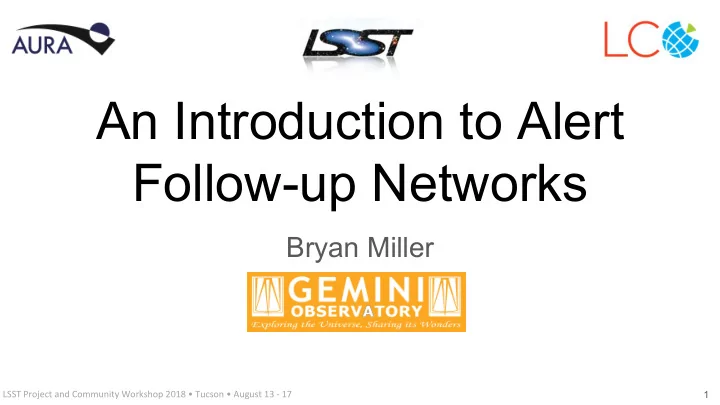

An Introduction to Alert Follow-up Networks Bryan Miller 1 LSST Project and Community Workshop 2018 • Tucson • August 13 - 17
Why all the fuss? In operation LSST will generate ~10 7 transient alerts per night! CANDELS (http://www.spacetelescope.org/images/heic1306d/) 10 4 alerts every ~2 min Science teams must select interesting targets. Observatories must prepare for Order(10-100) triggers/night/tel 2 LSST Project and Community Workshop 2018 • Tucson • August 13 - 17
Such high event rates will likely swamp current ToO handling procedures At Gemini, ToOs make up about 20-25% of the time in Band 1 • Max rates are 1-2/night • Many more will overwhelm the manual scheduling process and observers At CTIO/SOAR, ToOs interrupt visitor nights A new solution • Many more will be disruptive to standard is needed! programs 3 LSST Project and Community Workshop 2018 • Tucson • August 13 - 17
The proposed solution is a system that dynamically turns alerts into requested data. ZTF example: talk by Ridgway Talk by Soraisam on ANTARES. Talk by Bianco 4 LSST Project and Community Workshop 2018 • Tucson • August 13 - 17
TOMs request observations from the appropriate network resource, then a scheduler takes over Scheduling needs to be automatic, update frequently or as new observations arrive. Targets assigned to nodes based on site conditions, target visibility, requested resource, etc. 5 LSST Project and Community Workshop 2018 • Tucson • August 13 - 17
Las Cumbres Observatory (LCOgt) is an example of an operating telescope network 21 robotic telescopes: 0.4m, 1m, 2m Imaging and spectroscopy (on 1m and 2m) Both hemispheres and nearly complete longitudinal coverage 6 LSST Project and Community Workshop 2018 • Tucson • August 13 - 17
NOAO/SOAR/Las Cumbres/Gemini are working to dynamically schedule SOAR, Gemini, Blanco... Rachel Street (LCOgt, PS) Bryan Miller (Gemini, PS) Stephen Ridgway (NOAO, PS) Cesar Briceno (NOAO/SOAR) Andy Adamson (Gemini) John Blakeslee (Gemini) Adam Bolton (NOAO) Bob Blum (NOAO/LSST) Todd Boroson (LCOgt) Jay Elias (SOAR) Steve Heathcote (NOAO) Catherine Merrill (NOAO) Joanna Thomas-Osip (Gemini) 7 LSST Project and Community Workshop 2018 • Tucson • August 13 - 17
Astronomical Event Observatory Network (AEON): 1. Develop interfaces (APIs) a. Receive requests from TOMs b. Send schedule to telescopes c. Receive status 2. Incorporate SOAR into LCOgt network, execute observations on dedicated nights 3. Coordinate data pipelining and archiving efforts 4. Incorporate Gemini, modify scheduler to handle queue 5. Be ready to incorporate other facilities (Blanco, etc) 8 LSST Project and Community Workshop 2018 • Tucson • August 13 - 17
Las Cumbres and SOAR are working on APIs and automation Automating Goodman spectrograph operations via scripts Modifying LCOgt scheduler Will develop interfaces to accept a schedule and create scripts for taking observations. Tests in late 2019 9 LSST Project and Community Workshop 2018 • Tucson • August 13 - 17
We close the loop via data archives and reduction tools Gemini has developed a pure python image reduction package (2019) SOAR and Gemini are collaborating on spectroscopy reduction in python starting in 2018 New Gemini instruments come with reduction tools that work in our pipeline environment (DRAGONS). Automated processing is a goal for the LSST era 10 LSST Project and Community Workshop 2018 • Tucson • August 13 - 17
Gemini’s observation planning/scheduling tools must be improved to handle a higher ToO rate and any new follow-up modes. Current weaknesses: ● Queue observers switch between static plans as conditions change. ● Rapid ToOs disrupt the plan ● Managing timing windows ● It is difficult to support complicated cadences (eg. observe every N days, logarithmic cadences) 11 LSST Project and Community Workshop 2018 • Tucson • August 13 - 17
Improvements are being made under the OCS Upgrades Program Rethink system from first principles. New UIs for ease of use. AEON APIs for search, status, and triggering. Automated scheduling built on LCOgt adapts to ToOs and changing conditions. Part of AEON in ~2020+ See Oct 2017 Gemini Focus, pg. 20 12 LSST Project and Community Workshop 2018 • Tucson • August 13 - 17
The community should consider various issues related to increased follow-up. Allocation options: • PI projects through existing TACs (as now) • Community campaigns? ? • Increase the fraction of time in Fast Turnaround? • Single, system-wide AEON TAC (e.g. LLP)? ▪ Allocates time on all network resources ▪ Avoids multiple jeopardy from different TACs Should there be new modes? • “follow-LSST”? • Other? 13 LSST Project and Community Workshop 2018 • Tucson • August 13 - 17
Summary NOAO/SOAR/Gemini/LCOgt are developing an instance of an alert follow-up network that includes: ● Broker (alert filter) ● TOM (target/resource matching) ● Scheduling/execution of network nodes ● Data reduction pipelines There are many implications for how we will use or the network and facilities. We want your feedback so that we can develop a system that works for everyone and delivers the best science. 14 LSST Project and Community Workshop 2018 • Tucson • August 13 - 17
Gemini will support AEON with the ongoing OCS Upgrades Program Goals: • Rethink the purpose and UI from first principles • Make Phase 2 preparation much easier • Include new features that are not possible in the current code • Make the code maintainable and scalable See Oct 2017 Gemini Focus, pg. 20 15 LSST Project and Community Workshop 2018 • Tucson • August 13 - 17
Task-specific but consistent UIs ⇒ lower learning curve Physical conditions on target (FWHM) instead of conditions bins Calibration steps and observations automatically added, configs linked 16 LSST Project and Community Workshop 2018 • Tucson • August 13 - 17
The Phase 2 tool should be easier for new users, more capable for advanced users Include tools for visibilities, planning, etc Programmatic access (eg. APIs for scripts) for search, full control, and access to services (ITCs, AGS). 17 LSST Project and Community Workshop 2018 • Tucson • August 13 - 17
Recommend
More recommend